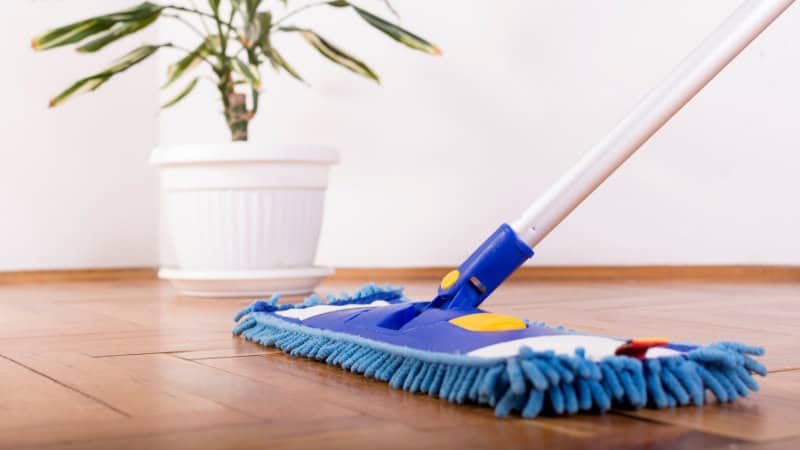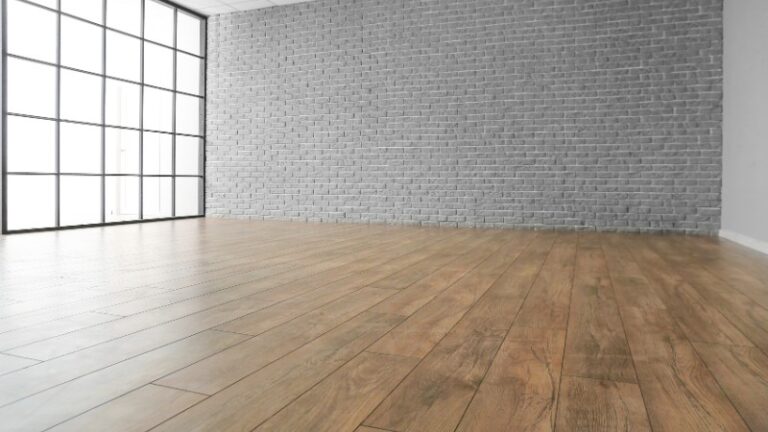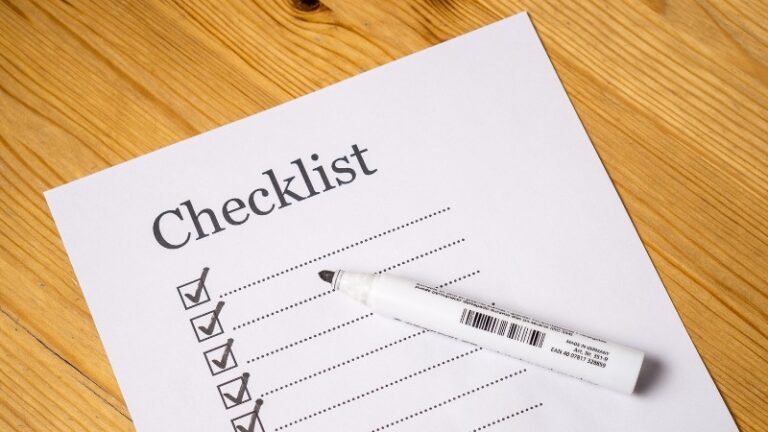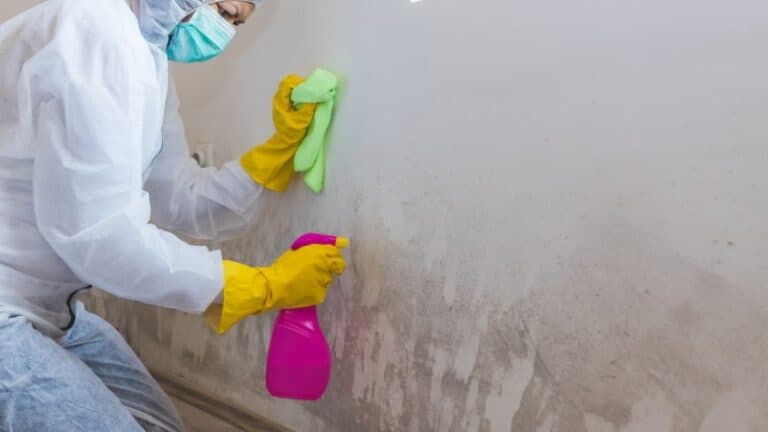Engineered hardwood floors give you the warmth and charm of real wood, without the fuss that comes with solid hardwood. They’re built for modern living — durable, stable, and stylish enough to elevate any space. But here’s the catch: even the toughest wood floors need a little TLC.
While engineered hardwood handles moisture better than traditional planks, it’s not invincible. Excessive water, the wrong tools, or harsh chemicals can leave your floors dull, warped, or worse.
This guide will show you exactly how to clean engineered hardwood floors without compromising the finish plus easy upkeep tips and when to call in the pros from Modern Maids.
Think of it as your no-fuss manual for keeping your wood floors looking showroom-ready. Ready to make that shine last? Let’s get into it.
Content
- 1 What Are Engineered Hardwood Floors and How Do You Care for Them?
- 2 How to Clean Engineered Hardwood Floors (Step-by-Step Guide)
- 3 5 Tips to Maintain Engineered Hardwood Floors
- 4 Leave It to the Pros – Book Modern Maids for Expert Floor Cleaning
- 5 FAQs
- 5.1 Can you use Dawn dish soap on engineered hardwood floors?
- 5.2 Is it safe to use vinegar on engineered hardwood floors?
- 5.3 Can an engineered wood floor be mopped?
- 5.4 What should you not put on engineered hardwood floors?
- 5.5 How often should you wash engineered hardwood floors?
- 5.6 Can mold grow under engineered hardwood?
What Are Engineered Hardwood Floors and How Do You Care for Them?

Engineered hardwood floors are a blend of beauty and resilience. They are made by layering a real hardwood veneer over a sturdy core of plywood or high density fiberboard. This structure gives you the natural charm of wood while offering more stability in areas where solid hardwood might struggle.
Because of this layered build, engineered wood floors can handle temperature shifts and moisture better than their traditional counterparts.
Unlike solid hardwood, which is milled from a single piece of wood, engineered hardwood is less prone to expanding or contracting. That makes it a reliable choice in places like kitchens or entryways where humidity and foot traffic can fluctuate throughout the day.
Still, it’s important to remember that the surface is real wood. That means it can be scratched by pet nails, dulled by rough materials, or stained if spills sit too long.
Many homeowners choose engineered hardwood as a long-term investment. It looks nearly identical to solid hardwood flooring and adds just as much value to your space.
If you’ve cleaned solid hardwood before, you’ll notice that cleaning engineered wood is quite similar. The biggest difference lies in how you manage moisture and the types of cleaning products you use.
Caring for these floors does not require a long list of specialty items. What matters most is consistency.
The key to preserving engineered hardwood floors lies in small, regular efforts. Cleaning up spills immediately, using a microfiber cloth for quick touchups, and avoiding abrasive cleaners will go a long way.
With proper maintenance, your floors will not only stay clean but will continue to add warmth and value to your home for years to come.
How to Clean Engineered Hardwood Floors (Step-by-Step Guide)
If your floors could talk, they’d probably ask for a little routine care rather than a deep scrub once in a while. Engineered hardwood may be built to last, but a simple weekly cleaning routine can keep it looking flawless and protect its finish from daily wear and tear.
Whether you’re doing a quick touch-up or your weekend clean-up ritual, this method is safe for most engineered hardwood finishes and easy to stick with.
Step 1: Sweep or Vacuum Daily

Start with the basics.
The easiest way to keep your engineered hardwood looking fresh is to sweep or vacuum daily. You don’t need anything fancy — a soft microfiber mop or a vacuum cleaner made for hard floors will do the job well.
Just make sure the vacuum doesn’t have a beater bar, since that can scuff the floor’s surface.
Loose dirt, pet hair, and even tiny bits of sand can act like sandpaper over time, dulling that beautiful wood’s surface. By removing debris regularly, you’re not just tidying up, you’re actively protecting the floor from unnecessary damage.
Think of it as brushing your teeth, but for your home’s floors. A little effort each day adds up to a long-lasting, polished look.
Step 2: Select the Right Cleaner

Once the floor is free of dust and crumbs, it’s time to move on to what you’re cleaning with.
This step can make or break the look of your engineered hardwood. Not all cleaners are created equal, and some can do more harm than good, even if they smell great or promise a deep clean.
To play it safe, always choose a pH neutral floor cleaner that’s specifically labeled for use on hardwood or engineered wood floors. These are gentle on your floor’s finish while still cutting through grime.
Steer clear of anything that contains ammonia, bleach, vinegar, or oil-based soaps. They might seem harmless, but over time, they can strip the finish, leave behind a residue, or cause the surface to dull.
If you prefer a homemade route, you can whip up a simple cleaning solution using just a few pantry staples.
Mix one cup of distilled water with a few drops of mild dish soap. Add 10 to 15 drops of your favorite essential oil if you want a subtle, fresh scent. This mix works well for light mopping and won’t compromise the floor’s surface.
Choosing the right cleaner means your floors get the shine without the stress.
Step 3: Mop Lightly with a Damp Cloth

Now that your cleaner is ready, it’s time to mop, but not like you would with tile or laminate flooring. When it comes to engineered hardwood, the key is a light touch. Think of it as a gentle touch-up for your floors, not a full-on drenching.
Grab a microfiber mop and dampen it slightly with your cleaning solution.
The goal is to have the mop just damp enough to lift dirt, not dripping wet. Too much moisture can seep between the boards and eventually cause warping or subfloor damage. If you wring out the mop and it still feels soaking wet, wring it out again.
As you move across the room, mop in the direction of the wood grain. This helps avoid streaks and keeps the finish looking smooth.
A streak-free shine and a healthy floor start with this simple habit. When done right, mopping becomes less of a chore and more of a satisfying refresh.
Step 4: Spot Clean Stains and Sticky Areas
Even with the most careful routine, life happens. A glass of juice spills during breakfast or muddy pawprints trail in after a walk. These little surprises are part of everyday living, but the good news is you can tackle them without damaging your engineered hardwood floors.
For fresh spills, act fast.
Wipe them up immediately using a clean towel or a dry microfiber cloth to prevent standing water from settling into the floor’s surface. For stickier spots or dried messes, apply your floor cleaner directly to a microfiber cloth or mop and gently rub the area.
Avoid scrubbing too hard. The goal is to lift the grime, not wear down the finish.
If a stain is being stubborn, you can try soaking a cloth in hydrogen peroxide and placing it directly over the spot. Leave it there for about six hours. This method helps pull the stain up from the wood without using abrasive cleaners.
Once the time is up, remove the cloth and wipe away any leftover moisture with a dry microfiber cloth.
Still see the mark? You can safely repeat the process.
Just remember to avoid scouring pads, steel wool, or anything rough. These might seem like a quick fix, but they can cause permanent scratches that are far harder to fix than a simple stain.
Step 5: Dry the Floor Immediately
You might think you are done after mopping or spot cleaning, but there is one final step that makes all the difference.
Drying the floor right away is what protects your engineered wood from subtle damage that builds up over time.
Even a light layer of moisture can lead to water spots or, worse, cause the wood to swell or warp if left alone. After you finish cleaning, take a dry microfiber cloth or a soft towel and go over the entire floor.
This step only takes a few extra minutes, but it goes a long way toward preserving the floor’s finish and structure.
Well-maintained wood floors are not just nicer to look at. They also last longer. In fact, floors that are cleaned and dried properly can last up to 30 percent longer than those that are left to air dry or exposed to too much moisture. A quick dry now means fewer problems later.
5 Tips to Maintain Engineered Hardwood Floors
Once your floors are clean and dry, the next step is keeping them that way. Maintenance is not just about cleaning often but about making small changes that protect your floors from everyday wear.
These simple habits can go a long way in preserving that rich wood finish and preventing damage before it happens.
1. Use Furniture Pads

Let’s start with something easy yet incredibly effective.
Adding felt pads under the legs of chairs, tables, and other furniture might not seem like a big deal, but it can save your floor from countless tiny scratches. Every time you pull out a chair or nudge the coffee table, the legs can leave fine marks on the wood’s surface.
Felt pads act as a buffer, allowing your furniture to glide without scraping.
They are inexpensive, easy to apply, and an essential part of protecting engineered hardwood floors, especially in high traffic areas like dining rooms and home offices.
2. Place Rugs in High-Traffic Areas

Think of rugs as your floor’s first line of defense.
While engineered hardwood is built to hold up under pressure, constant foot traffic can still wear down the finish over time. Areas like hallways, entryways, living rooms, and kitchens tend to take the brunt of everyday activity.
Placing entry mats and runners in these spots helps catch dirt before it spreads across the entire floor. Rugs also absorb minor spills and reduce the impact of heavy foot traffic.
Choose ones with non-slip backings that will not damage the floor underneath, and avoid rubber mats that can trap moisture. With the right rugs in place, your floors get both style and protection in one step.
3. Control Humidity Indoors

Your floors might look tough, but they still react to the environment around them. One of the most overlooked ways to maintain engineered hardwood is by keeping indoor humidity in check. When the air is too dry, the wood can shrink and crack.
When it is too humid, the planks can swell or cup, which affects both the appearance and structure of the floor.
Aim to keep humidity levels between 30 and 50 percent throughout the year. If you live in a dry climate or are running the heater all winter, a humidifier can help maintain balance. In contrast, during damp months or rainy seasons, a dehumidifier can prevent excess moisture from creeping in.
Engineered wood may handle humidity better than solid hardwood, but it still needs a stable environment to look its best for years to come.
4. Avoid Wet Mops and Steam Cleaners

It is tempting to grab a steam mop or run a soaked mop across the floor for a deep clean, but that kind of moisture is your floor’s worst enemy.
Engineered wood may be more stable than solid hardwood, but it is still made with real wood and layers that can separate if exposed to too much heat or water.
Steam can force moisture into the floor’s surface, loosening the layers and damaging the adhesive that holds them together. Soaking wet mops can have the same effect, leaving behind standing water that seeps between boards.
Instead, always use a lightly damp microfiber mop and wring it out thoroughly. A little moisture goes a long way, and sticking to damp-only cleaning helps prevent long-term damage while keeping your floors in top condition.
5. Refresh the Finish When Needed
Even the best cared-for floors will show signs of age eventually. If your engineered hardwood starts to look dull or loses its smooth feel, it might be time for a little refresh. The finish on your floor acts like armor, protecting the wood from scratches, stains, and moisture.
When that layer wears down, the floor becomes more vulnerable to everyday damage.
In most cases, you can restore its appearance by recoating the surface with a fresh layer of polyurethane. This process revives the shine and adds a new layer of protection without having to fully replace or sand the floor.
However, not all engineered floors are created equal. Some have thinner top layers that cannot handle sanding or aggressive refinishing. That is why it is always best to consult a flooring professional before doing anything beyond surface-level maintenance.
A quick expert check can help you avoid costly mistakes and keep your floor’s finish looking like new.
Leave It to the Pros – Book Modern Maids for Expert Floor Cleaning
Engineered hardwood may be easier to care for than solid wood, but it still demands the right approach. One wrong cleaner or an overly wet mop can turn a beautiful floor into a costly repair project. That is where Modern Maids comes in.
Our team uses floor-safe products, microfiber tools, and techniques that bring out the best in your wood floors without risking their finish. Whether you are juggling work, kids, or just want one less thing on your to-do list, we make it easy to keep your home spotless and your floors shining.
Want gleaming wood floors without the second-guessing or extra effort?
Let Modern Maids do the mopping while you enjoy the shine. Call us at (469) 430 8860 or book your cleaning online at modern-maids.com — your floors will thank you for it.
FAQs
Can you use Dawn dish soap on engineered hardwood floors?
Yes, you can use a small amount of Dawn dish soap on engineered hardwood floors, as long as it is properly diluted. Mix a few drops with warm water and use a damp mop to clean the surface. Avoid using too much moisture and always wring out the mop thoroughly. This mild dish soap is gentle on the floor’s finish and effective at removing light dirt and grease without causing damage. For best results, follow up with a dry microfiber cloth to remove excess moisture and leave a streak-free finish.
Is it safe to use vinegar on engineered hardwood floors?
Vinegar might seem like a natural cleaning solution, but it is not safe for engineered hardwood floors. Its acidity can break down the floor’s finish over time, leading to a dull or damaged surface. Even when diluted, vinegar can be too harsh and is not recommended by most flooring manufacturers. To clean engineered wood floors safely, stick with a pH neutral cleaner or a homemade solution with mild dish soap. Avoid harsh chemicals and always choose products designed for hardwood surfaces to protect your investment.
Can an engineered wood floor be mopped?
Yes, you can mop an engineered wood floor, but it must be done with care. Use a damp mop, not a wet mop, and avoid excessive moisture. A microfiber mop slightly dampened with warm water or a gentle cleaning solution is best. Too much moisture can seep into the layers and cause warping or damage over time. Always wring out the mop thoroughly and follow up with a dry microfiber cloth to remove any lingering dampness from the floor’s surface.
What should you not put on engineered hardwood floors?
Avoid using harsh chemicals, abrasive cleaners, or steam mops on engineered hardwood floors. Products like ammonia based cleaners, oil soaps, and bleach can damage the finish and dull the wood’s surface. Stay away from rough materials such as steel wool or scouring pads, as they can scratch the floor. You should also avoid excessive moisture or soaking wet mops, since too much moisture can lead to warping or separation of the engineered layers. Always use floor cleaner made specifically for wood floors.
How often should you wash engineered hardwood floors?
For most homes, engineered hardwood floors should be washed every one to two weeks, depending on foot traffic and lifestyle. High traffic areas may need more frequent cleaning, while less used spaces can go longer between washes. Regularly sweep or vacuum with a soft bristle broom or vacuum cleaner to remove dust and loose dirt. For washing, use a damp mop with a safe cleaning solution and avoid too much moisture. Consistent care helps protect the wood’s surface and maintains indoor air quality.
Can mold grow under engineered hardwood?
Yes, mold can grow under engineered hardwood floors if excessive moisture is trapped beneath the surface. Standing water, leaks, or high humidity levels can seep through the planks and affect the subfloor or core layers made of plywood or high density fiberboard. Over time, this can lead to mold and mildew growth. To prevent this, clean spills immediately, avoid excessive moisture during cleaning, and keep indoor humidity levels between 30 and 50 percent. Proper ventilation and regular cleaning are key to keeping your engineered floors mold free.







